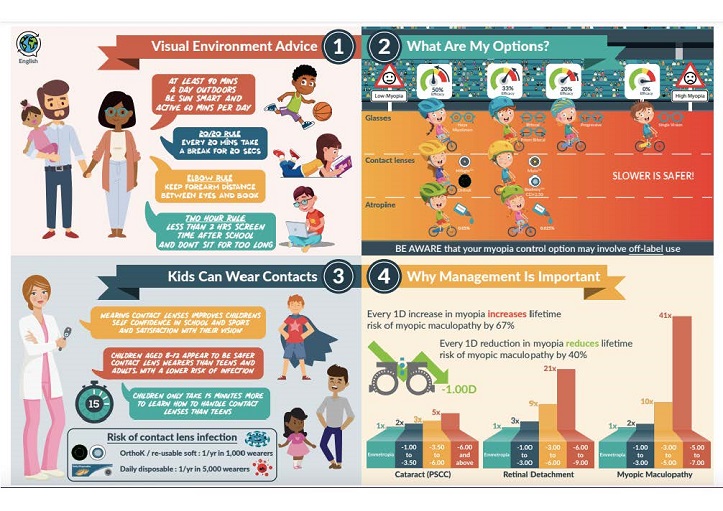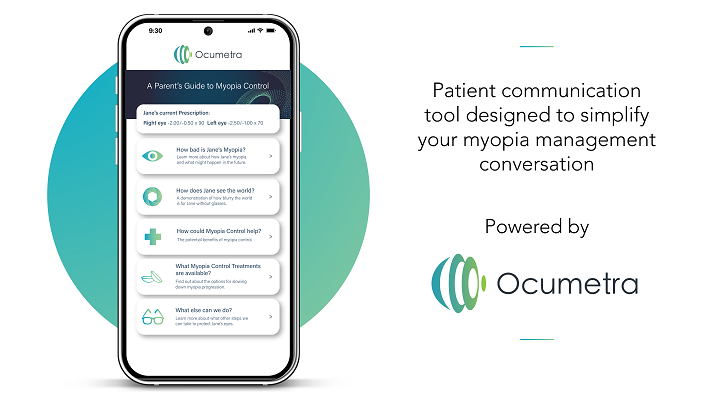
Author: James Loughman
7 April 2022
Effective Communication: The Key to Success in Myopia Management - Part 1
The emergence of new therapies to limit myopia progression offers eyecare practitioners (ECPs) the opportunity to deliver better health outcomes for their patients. Despite growing calls for myopia control to become the new standard of care,(1)uptake of these new treatments by practitioners is still limited. Managing childhood myopia to control progression is a more complex process relative to conventional vision correction and needs to be supported by enhanced education and technology. Monitoring eye health and myopia can be facilitated through optical practice management software and eyecare software, which provides practitioners with tools to track patient progress and develop personalised treatment plans.
The additional chair time and continuity of care requirements to best serve individual patient needs are also significant concerns. Importantly, adopting myopia control as a new therapeutic priority in clinical practice presents unique communication challenges for ECPs. In addition to the detailed initial conversation required to promote uptake, discussions at follow-up visits need to delve into areas such as treatment efficacy, compliance and retention.
"The importance of creating awareness around the causes of myopia and the benefits of myopia control cannot be underestimated. Parents can play an integral role, given their particular influence on the lifestyle choices of children."
Unique communication challenges
The importance of creating awareness around the causes of myopia and the benefits of myopia control cannot be underestimated. Parents can play an integral role, given their particular influence on the lifestyle choices of children. The success of any strategy that requires acceptance of new treatments for children will depend on parental awareness of the condition and their acceptance of the proposed interventions as a necessary treatment option. Research conducted at the Centre for Eye Research Ireland (CERI) has explored parental attitudes and awareness of myopia and its control. It is clear from this study that parents do not understand the health risks of eye disease and vision loss associated with myopia (2).
Furthermore, although parents are motivated to avoid ocular damage to their child’s eyes from myopia, they are not aware of how this can be achieved. There is a clear need, therefore, for practitioners to ensure that the concept of myopia control and its potential benefits for children at risk of myopia progression are understood by parents. Some of the key communication challenges ECPs will face in implementing a myopia management program include:
Challenge 1 – Explaining myopia control
Parents typically understand that spectacles improve vision, but most do not yet understand the difference between myopia correction and control (3). The initial requirement is for ECPs to introduce the concept of myopia control to suitable patients and their parents.
Challenge 2 – Explaining what’s involved
Once myopia control is explained, the ECP is tasked with illustrating the need for a comprehensive management plan for an individual child, exploring the various treatment options, explaining benefits and highlighting costs. The central requirement here is to promote uptake of myopia control treatments by every at-risk patient. New treatments are expensive, so ECPs need to justify their prescribed management plan in relation to the therapeutic need and potential benefits that might accrue.
Challenge 3 – Managing expectations
Once parental consent is obtained and a management plan is in place, the communication focus needs to switch to managing parent expectations. This should include the possibility that treatment may need to be adapted or changed if the patient fails to respond satisfactorily to the initial treatment. Setting realistic expectations is important as the benefits of treatment are often not immediately visible to patients and parents. Vision correction delivers immediate results as it resolves the symptoms of myopia, whereas the health benefits of myopia control may not become evident until several decades after the period of treatment. Managing the risk of disease is more complex as a communication task relative to managing disease itself, where a positive response to treatment provides a more tangible outcome for those affected.
Challenge 4 – Promoting ongoing compliance and retention
Patient retention is an important problem to be addressed as eye growth and myopia progression are likely to happen during treatment. Patients may not persist with expensive treatments if the benefits cannot be demonstrated and explained at ongoing follow-up visits. These treatments are required for an indefinite period depending on each patient’s age, gender, ethnicity and the individual level of risk involved. Effective ongoing patient communication is key to maintaining compliance with treatment and ensuring that treatment will not be terminated prematurely.
From the ECP perspective, two factors are key to enhancing engagement with active myopia management. The first is to have a plan for how to start the myopia control conversation with parents, while the second is to figure out how to simplify and shorten the conversation so that (a) patients buy into the concept and accept the prescribed treatment and (b) valuable chair time is not wasted on lengthy and ultimately fruitless conversations.

Myopia Profile provides parent-facing infographics called ‘Protecting Children from Myopia’, which are designed to help ECPs communicate with parents regarding myopia management including information on environmental advice; explaining the efficacy of myopia management options, contact lens safety and benefits for children, and why myopia management is important.
Starting the Conversation
In its broadest sense, myopia management can and should start with a conversation that something can be done if a child’s myopia is progressing. Simple advice, such as asking about time outdoors and letting parents know that options exist for myopia control, are useful starting points. Most parents are highly receptive to the simple message that there is something that can be done to stop their child’s vision from getting worse. Convincing a parent that they should subscribe to the significantly higher costs and everyday requirements of a new myopia management regimen is, however, a very different and potentially more difficult conversation.
Simplifying the Myopia Management Conversation
Recognizing the various communication challenges clinicians face, new patient communication tools designed to simplify the myopia management conversation are soon to become available to ECPs. These tools are designed to easily and quickly answer the key questions every parent needs answered before committing to myopia control, including:
- What is the difference between myopia correction and myopia control?
- Why does my child need myopia control?
- What are the benefits of treatment?
- What are the risks of going without treatment?
- What treatment options are available?
- What else can I do to help stop my child’s vision from getting worse?

Closing Thoughts
New strategies to control myopia progression in children will depend heavily on the informed participation of parents. The communication task might seem daunting given that (i) traditional vision correction based management has been around for centuries and is well understood and accepted, (ii) parents don’t understand myopia control and (iii) the health benefits of treatment are not easy to demonstrate to patients. However, emerging myopia control educational tools can revolutionize the myopia treatment conversation. In Part 2 of this blog, we will demonstrate one of these new tools and focus on how ECPs can use them to turn a long and potentially complex conversation into a short and effective one.
Ocuco offers innovative eyecare software, designed for independents, chains, and labs. Whether you need optical retail shop software for your independent optical retail shop, optical chain software to manage a chain business or optical lab management software for your lab, we have the ideal solution for your optical needs.
Are you looking for optical practice management software? Acuitas offers product management, electronic health record systems, appointments and multiple configurations to meet the specific needs of your optical business. Contact us today for free expert advice.
Additional Reading
1. Managing myopia: Evolution of a new standard of care. James Loughman Ocuco Blog, August 2021.
2. Keys to effective communication in myopia management. Myopia Profile, February 2021. https://www.myopiaprofile.com/keys-to-communication-in-myopia-management/
3. McCrann S, Flitcroft DI, Lalor K, Bush A, Loughman J. Parental attitudes to myopia: A key agent of change for myopia control? Ophthalmic & Physiol Opt 2018; 38: 298–308. DOI: 10.1111/opo.12455 https://arrow.dit.ie/scschphyart/78
4. Centre for Eye Research Ireland website downloadable parent information resources: https://www.ceri.ie/Clinic.html
James Loughman is the Clinical Research Director for Ocuco Ltd.
An Optometrist with more than 20 years of clinical, academic, research and management experience, James recently joined Ocuco as Clinical Research Director. James is also presently the Director of the Centre for Eye Research Ireland, a research facility based in the Dublin Institute of Technology, the same university where he received his PhD in 1997; James oversees a portfolio of research including technology development and big data analytics projects alongside various clinical trials for the control of myopia, glaucoma and other blinding conditions.